

| Other cities in Texas competed for the sponsorship of the Centennial, but Dallas, which had not even existed at the time the Republic of Texas was founded in 1836, was awarded the site for the Texas Centennial Exposition. The Exposition built on the grounds of the Texas State Fair. This popular and extensively marketed event was an important promotional effort for Dallas at this time when it needed the economic boost during the Great Depression.
George L. Dahl, the Centennial architect, designed a symmetrical Beaux arts master plan with a 1500 foot Esplanade of State (with a 700 foot reflecting pool) flanked by six large long pavilions. The focus of the Esplanade and symbolic center of the celebration is the Hall of State, originally called the State of Texas Building. A large group of Texas architects participated in the whole project but when the plan for the Hall of State was stalled, Houston architect, Donald Barthelme, was called in to provide a synthesis of existing plans. A student of Paul Cret, the Design Consultant for the project, Barthelme's design reflects Cret's Modernism. (See Cret's Folger Library.) However, other Fair projects at this time also used this sleek, clean, planar style--a blend of classicism and Art Deco, with in this case some particular Texas motifs--cactus, oils wells, etc. This Hall of State was the most expensive building per square foot of any structure thus far built in Texas. It was constructed at a cost of $1,200,000, an incredible amount for 1936, during the Depression. | ||

|

|
The Hall of State is built of Texas limestone and incorporates the designs in the interior of a large team of artists who sing the praises of the state of Texas and its heroes. |
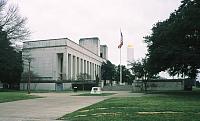
|

|

|
The central exedraThis curved exedra is flanked by lower lateral wings with a classical peristyle. Piers are simple, without bases or capitals. The plan is an inverted "T" (for Texas?) |
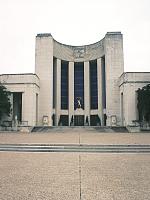
|

|
| The bronze doors are also symbolic with designs representing the Texas industries and activities--"a cowboy's lariat, a saw-blade with a pine-cone in its center, a circle of oil derricks surrounding a gusher, cotton bolls and wheat sheaves, cattle, and ponies" (web site). Allie Tennant's heroic eleven-foot tall golden statue of the Tejas Indian (bronze covered with gold leaf) is over the entrance. The blue tiles represent the state flower, the bluebonnet. | ||

|
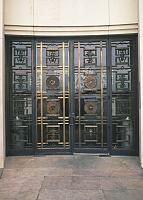
|
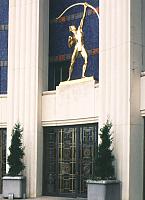
|
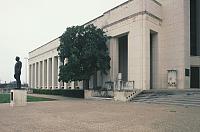
|
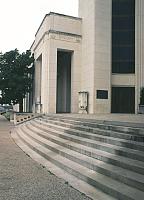
|
The bronze statue (left photo, far left) is of R. L. Thornton, the Mercantile Bank president, civic leader and former Mayor of Dallas as well as president of the State Fair of Texas. He was the prime mover behind the selection of Dallas for the site of the Exposition as well as a principal fund raiser. |
The peristyle |

|
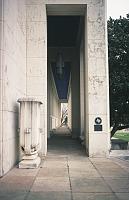
|
Other detailsFifty-nine Texans are honored on the frieze (far right); generally only the last names are cited (except note Stephen F. Austin) As this website notes, "There is also a little secret worked into the frieze: the first letter of the first eight names you see, as you face the building's front and read from left to right, spells out the last name of the architect who designed the Hall of State - Donald Barthleme (only the final "e" is missing)". | ||
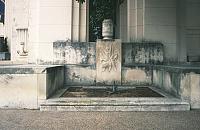
|
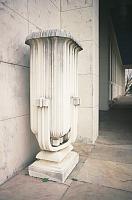
|
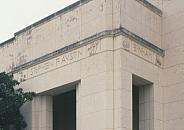
|
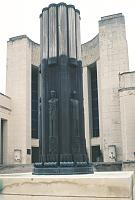
|

|
Lamp post and lighting fixtureThe lamp-posts (far left) also celebrate Texas history with bronze historical figures--a pioneer and Confederate soldier, for example. |
 Click here to return to index of art historical sites.
Click here to return to index of art historical sites.
 Click here to return to index of artists and architects.
Click here to return to index of artists and architects.
 Click here to return to chronological index.
Click here to return to chronological index.
 Click here to see the home page of Bluffton College.
Click here to see the home page of Bluffton College.
